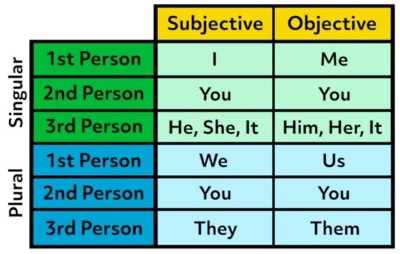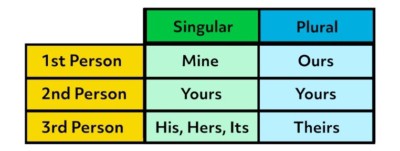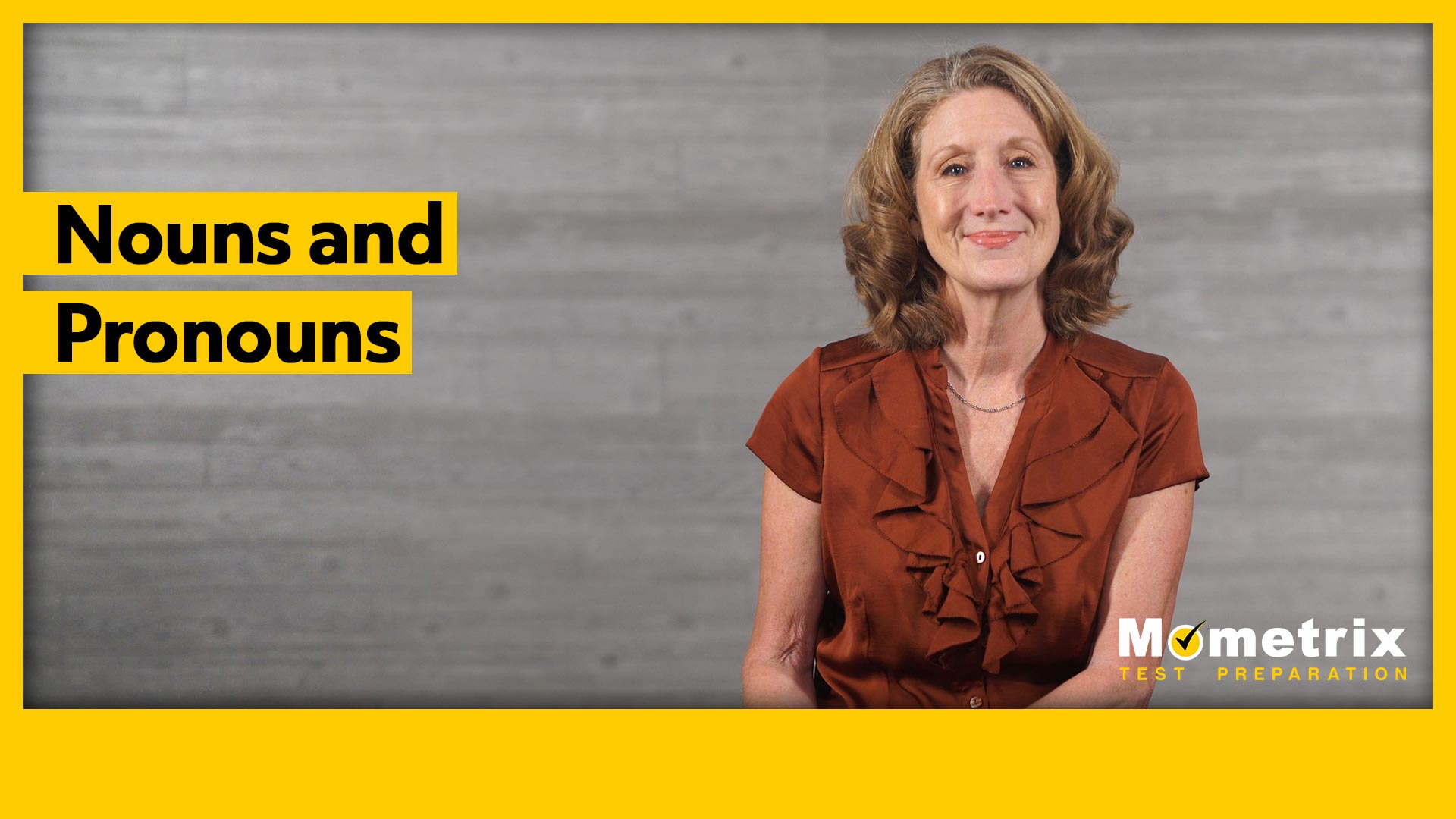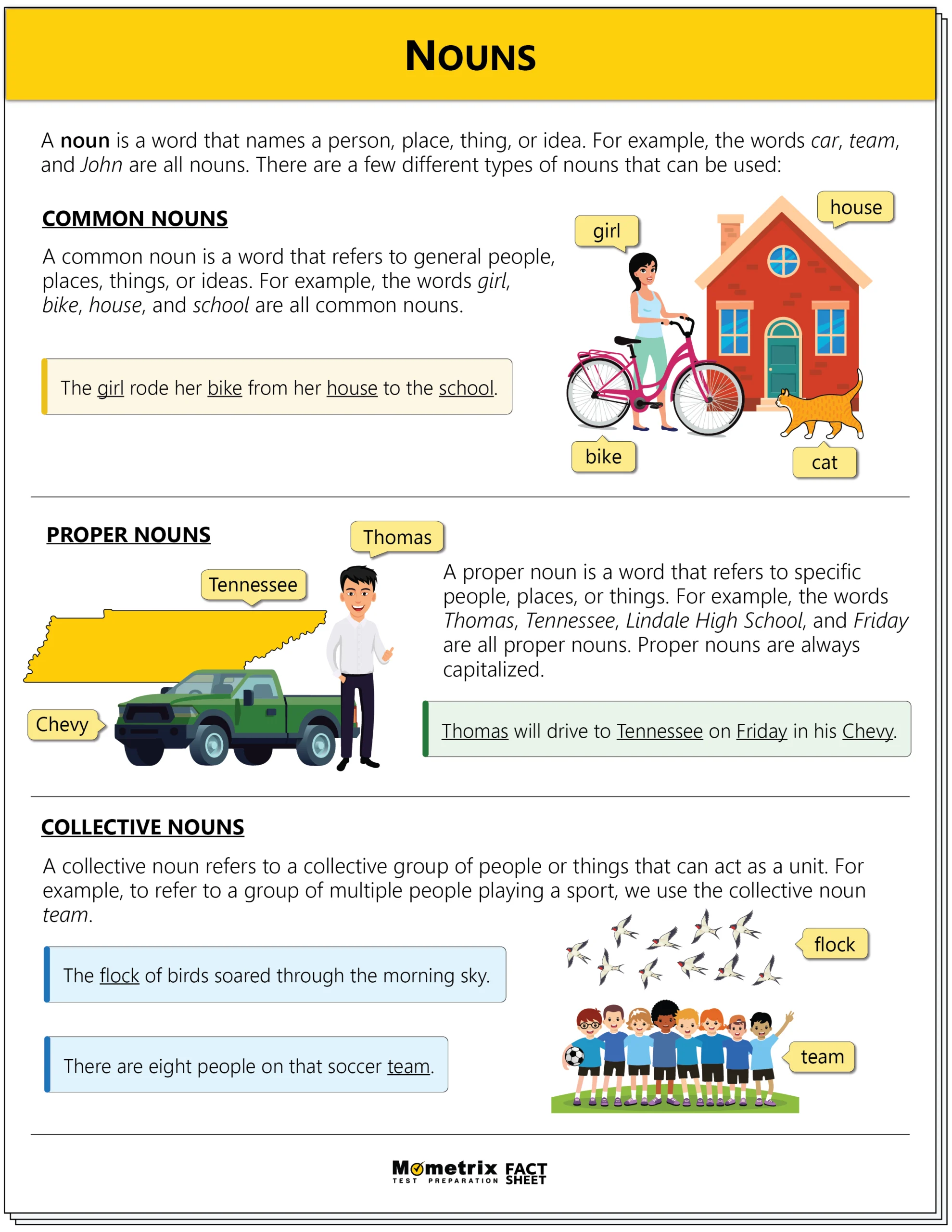
Nouns
Nouns are one of the most common types of words that we use in sentences every day, whether it be in conversations with friends or writing an essay for class. In this video, we’ll be taking a look at all of the different types of nouns and how they function in sentences, and we’ll also see how nouns and pronouns work together to make sentences flow smoothly. Let’s get started!
Nouns are words that name a person, place, thing, or idea. For example, sister and Lindsey are people, school and Halsted Street are places, puppy and tree are things, and happiness and energy are ideas, so all of these words are nouns!
| Person | sister, Lindsey |
| Place | school, Halsted St. |
| Thing | puppy, tree |
| Idea | happiness, energy |
Nouns can be broken down even further into different categories depending on what the noun is doing in the sentence.
Common Nouns
| Common/General Noun |
|---|
| canyon |
| woman |
| rabbit |
| doctor |
| car |
Common nouns, like these, are words that refer to general people, places, things, and ideas. This means that a common noun is not given a specific name or title like John or Eiffel Tower (we’ll talk about names a little later on). Here’s an example of a common noun used in a sentence:
The common noun used in this example is dinner, which, in this case, is a thing. Let’s look at one more.
This sentence has multiple common nouns, for example, doctor and park. In this case, these common nouns are a person and a place. Seems simple enough, right?
Now let’s look at proper nouns.
Proper Nouns
| Proper Noun |
|---|
| Grand Canyon |
| Margaret |
| Dad |
| Tomball Lane |
Proper nouns are people, places, or things that have specific names or titles, and they are always capitalized. For instance, the word road is a common noun, but Tomball Lane is the specific name of the road, so Tomball Lane is a proper noun.
Here’s an example sentence:
There are two proper nouns in this sentence: Rachel and Arizona. These are specific names of a person and a place, and they are both capitalized. The word car, on the other hand, is a common noun since we’re not mentioning the car by a specific name or title.
Now, take a look at these two sentences:
Kiera, do you know what Dad is making for dinner?
The word dad is used in both of these sentences, but notice how it’s capitalized in one sentence and not capitalized in the other. Why is that? Well, in the first sentence, dad is a common noun, meaning we aren’t using dad as a specific name or title. In the second sentence, dad is used as the name of a specific person, so it is considered a proper noun.
Plural Nouns
Now, as you might expect, nouns can be singular or plural. Just as it sounds, a singular noun describes a single thing, while a plural noun refers to multiple things.
There are a few different ways to make a singular noun plural, depending on what letter the noun ends with. The general rule is that you add an s to the end of a noun to make it plural, like in the words bat, car, and table.
car → cars
table → tables
doll → dolls
If a singular noun ends with s, x, z, ch, sh, or ss, you add -es to the end to make it plural.
fox → foxes
buzz → buzzes
wrench → wrenches
bush → bushes
glass → glasses
If a word ends with y, there are two different rules to keep in mind. If the letter before the y is a consonant, you remove the y and add -ies to the end.
lady → ladies
enemy → enemies
fly → flies
city → cities
For instance, to make the word city plural, you would replace the y with -ies because the letter before the y is a consonant, t. If a vowel precedes the y, then you simply add the letter s to the end.
toy → toys
alley → alleys
donkey → donkeys
There are also two different rules to follow if a noun ends with o. If the letter before the o is a consonant, you add -es to the end to make it plural.
volcano → volcanoes
tomato → tomatoes
potato → potatoes
If the letter before the o is a vowel, you simply add the letter s to the end to make it plural.
stereo → stereos
video → videos
audio → audios
If a noun ends with f or fe, you need to change the ending to -ves. This means that half becomes halves and knife becomes knives.
knife → knives
half → halves
shelf → shelves
Now, as with all rules, there are definitely exceptions to all of these we’ve just discussed. For instance, the plural of child is not childs (it’s children), and the plural of tooth is not tooths (it’s teeth). These are examples of what we call irregular plurals.
woman → women
child → children
tooth → teeth
sheep → sheep
deer → deer
fish → fish
moose → moose
Since there is no hard-and-fast rule for these plurals, you’ll need to memorize them as you come across them.
Now that we know all about singular and plural nouns, let’s move on to possessive nouns.
Possessive Nouns
Possessive nouns are nouns that describe ownership of something. We show ownership by adding an apostrophe and an s to the end of a singular noun and only an apostrophe to a plural noun that ends with s.
Take a look at this example:
In this sentence, we see three nouns but only one of them is possessive. Mom’s is the possessive noun because the car belongs to her, not Liz.
Nouns that don’t refer to humans or animals can also be possessive.
In this example, the possessive noun is trees’ because the leaves mentioned belong to the trees. Did you notice the placement of the apostrophe? Because trees is plural, we just add an apostrophe to the end and do not add another s after it.
As I mentioned before, if a noun is plural but does not end with s, you add an apostrophe and an s to the end to make it possessive.
the sheep‘s bleating
the geese‘s pond
the mice‘s tail
Collective Nouns
Before we move on to pronouns, let’s take a look at collective nouns. Collective nouns are nouns that refer to a group of people or things. For instance, if you’re referring to a group of multiple people playing a sport, you would use the collective noun team.
A flock of birds
A team of players
A crowd of fans
All right, now that we’ve discussed several different types of nouns, let’s move on to pronouns.
Pronouns
Pronouns are words that take the place of nouns. In other words, pronouns can describe a person, place, or thing without you having to name it multiple times in the same sentence or paragraph, which alleviates unnecessary repetition. The noun that the pronoun is replacing is called the antecedent.
Personal Pronouns
Let’s first take a look at personal pronouns.

These are pronouns that are used to refer to people. For example, instead of saying “When Tina walked in the house, Tina took off Tina’s shoes,” you could use the pronouns her and she to replace the noun Tina:
When a personal pronoun is acting as the subject of a sentence or phrase, we call it a subjective personal pronoun, and when it’s acting as the object, we call it an objective personal pronoun.
In this sentence, for example, they is a subjective pronoun and us is an objective pronoun.
Possessive Pronouns
Just like nouns, pronouns can be used to show possession; we call these “possessive pronouns.”

Take a look at this sentence:
In this example, the possessive pronoun hers is replacing the noun notebook. If we had not used a pronoun here, we would have said “It looks like this notebook is her notebook,” which is a bit repetitive.
This is when it becomes important to know the difference between possessive pronouns and possessive adjectives, because they’re often confused with each other. A possessive pronoun takes the place of a noun, while a possessive adjective describes a noun. For example, the word my is a possessive adjective (“I’m reading my book”), but the word mine is a possessive pronoun (“The book is mine.”).
Demonstrative Pronouns
Demonstrative pronouns are used to refer to specific things that are either near or far away.

For instance, if you wanted to refer to a book that you’re holding, you would say “Could you put this on Mark’s desk?” Notice that the pronoun this completely replaces the word book; that’s what makes it a pronoun. If we said “Could you put this book on Mark’s desk?” the word this is an adjective describing the word book, not a pronoun replacing the word book.
Interrogative Pronouns
Interrogative pronouns are used to refer to nouns in the form of a question.
which
who
whom
whose
Here’s an example:
In this sentence, the interrogative pronoun who is taking the place of the noun that answers the question. In other words, if we said “Percy invented the microwave oven,” the pronoun who takes the place of the proper noun Percy.
Once again, it’s important not to confuse interrogative pronouns with interrogative adjectives. If I say “Whose jacket is this?” the word whose is not a pronoun—it’s an adjective. For whose to be a pronoun, I would have to say “Whose is this?” In that case, it’s a pronoun because it completely takes the place of the noun jacket.
Remember, an interrogative pronoun takes the place of a noun, while an interrogative adjective describes a noun.
Indefinite Pronouns
Indefinite pronouns are used to refer to non-specific people, things, or amounts.
| all | another |
| any | anyone |
| anything | each |
| everyone | few |
| many | neither |
| several | some |
Take this sentence for example:
In this case, the indefinite pronoun is anybody because it refers to an immeasurable amount of people.
Okay, we’ve discussed a lot about nouns and pronouns, so let’s go over a few review questions before we go.
1. What kind of noun is Tuesday?
- Common noun
- Possessive noun
- Proper noun
- Collective noun
The word Tuesday is a specific name, so it is a proper noun.
2. Which of the following singular nouns was pluralized incorrectly?
- singer → singers
- dish → dishes
- church → churches
- tax → taxs
Remember, nouns that end in -x require an -es ending to make them plural.
3. Which word in the following sentence is an objective pronoun?
She caught them cheating on their homework assignment this morning.
- she
- them
- their
- this
The word them is an objective pronoun because it acts as the direct object of the sentence. The word she is a subjective pronoun in this sentence, while their and this are both adjectives.
4. Which of the following sentences contains an interrogative pronoun?
- Whose is this?
- Which one is hers?
- What kind is that?
- Where is it?
Remember, an interrogative pronoun takes the place of a noun, while an interrogative adjective describes a noun.
All right, that’s all for this video! Thanks for watching, and happy studying!
Nouns and Pronouns Practice Questions
Which of the following nouns represents the correct plural form of the word wrench?
Since the noun wrench ends with the ch, it is made plural by adding es to the end.
Fill in the blanks:
The _______ bright blue hue matched my freshly painted _______.
The bright blue hue belongs to the sky, so the word sky needs to become possessive, which is formed by simply adding ‘s to the end. The word nail is not possessive in this case but is plural, so an s is added to the end.
Select the correct capitalization for the underlined nouns:
Last year, aunt kim took a trip to france with jerel
and his mom.
Aunt Kim is the given name of a person. This makes it a proper noun, which should be capitalized. France is the name of a country, which is also a proper noun and, therefore, capitalized. Jerel is a person’s name, which makes it another proper noun that should be capitalized. In this sentence, the word mom is not the given name of a person, so it is not a proper noun and is therefore left uncapitalized.
Which word is the collective noun in the following sentence?
The class of junior high students left their papers in the auditorium.
Remember, collective nouns refer to a collective group or multiple number of something. The word auditorium is a common noun that references a single place, so it is not a collective noun. The words students and papers are both plural nouns, but neither word refers to a collective group. The only word that does that in this sentence is the word class, which refers to a group of people.
Fill in the blank:
All of the _______ cores were heaped in a pile under the table.
This sentence is referring to the cores of multiple apples, so the plural possessive apples’ should fill in the blank.
Fill in the blanks:
Cameron was holding a large box; ____ was full of ____ favorite books.
The first blank should be filled by the pronoun it, which is referring back to the noun box. The second blank should be filled by the pronoun her, which is referring back to the proper noun Cameron.
Fill in the blank:
The crowd made _____ way to the auditorium just in time for the recital to begin.
The word crowd is a collective noun, which means it refers to a group of people but is itself a singular noun. Because it is singular, the pronoun its should be used here.
The words other, nobody, anybody, and none are examples of which type of pronoun?
Indefinite pronouns represent a person or thing that we don’t have a specific number of.
Which of the following is a reciprocal pronoun?
Reciprocal pronouns indicate that two or more people are carrying out an action at the same time.
What two types of pronouns are found in the following sentence:
I myself prefer biking over running.
In this sentence, the pronoun I is personal, and the pronoun myself is intensive.



